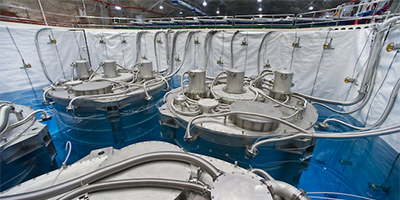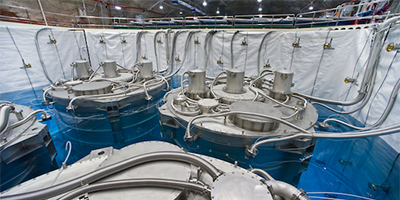Searching for Sterile Neutrinos
An indispensable piece of the standard model of particle physics is its three neutrino flavors (electron, muon, and tau), which are responsible for mediating the weak interaction. The Daya Bay Reactor Neutrino Experiment in China has reported a search for a conjectured fourth type of neutrino—dubbed a “sterile” neutrino, as it cannot participate in the weak interaction. While no trace of the particle was seen, the experiment has placed some of the most stringent limits to date on its mass and mixing with other neutrino flavors.
Neutrinos can morph between the three available flavors as they travel through space through so-called neutrino flavor oscillations, whose probability depends on a set of three parameters called mixing angles. To probe such oscillations, the Daya Bay Collaboration uses six electron antineutrino detectors located at distances ranging from a few hundred to almost two thousand meters from six nuclear reactors. The reactors produce copious amounts of electron antineutrinos, and if such antineutrinos convert into a different flavor before they reach one of the detectors, the observed shortfall indicates neutrino oscillations.
Daya Bay’s capabilities led to the remarkable discovery of a larger than expected standard-model mixing angle, , governing the rate of electron neutrino conversion to other flavors (see 23 April 2012 Viewpoint), which shook the world of particle physics in 2012. Through the same type of experiment, Daya Bay has now set new limits on the hypothetical sterile neutrino’s mass and mixing with the three known flavors of the standard model through a new mixing angle . The result will aid scientists constructing better neutrino models and may have consequences beyond particle physics, as sterile neutrinos have been a popular dark matter candidate.
This research is published in Physical Review Letters.
–Kevin Dusling





